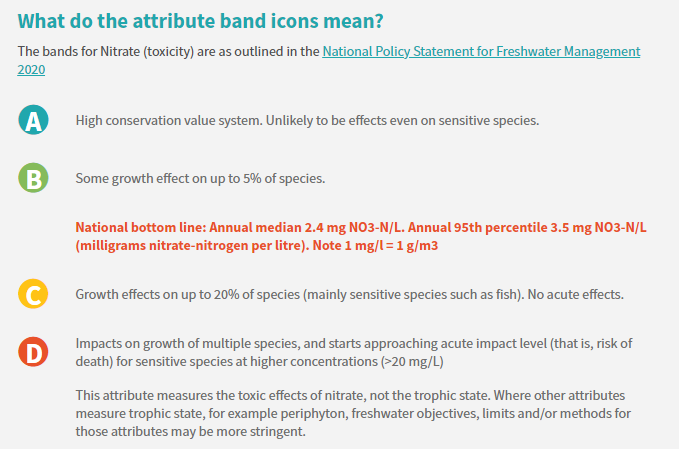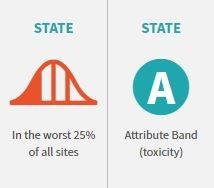Why are we recording the current state of our freshwaters?
We measure the current state of our rivers, streams and lakes to get an idea about whether our water is suitable for use for various purposes, and about the effect of different pressures (e.g. urbanisation, farming, etc.) on the condition of our freshwater ecosystems.
Some influence from people on our waterways is an inevitable outcome of supporting our communities and primary producers, and it is unlikely that we can return some water bodies in New Zealand to their pre-human state. Even where human pressures could be almost completely removed, such as within national parks, introduced aquatic species, as well as native and exotic birds, insects and pest mammals, and natural processes such as erosion and atmospheric pollution, impact the health of our waterways to some extent.
How is State calculated for our rivers and streams?
Current state in the LAWA River Quality topic is described using two independent methods: via state quartiles and attribute band scores. The state quartiles are a relative measure at the national scale, comparing sites against each other, while the attribute band scores are an absolute measure, evaluating each site against expectations of water quality values in the National Policy Statement for Freshwater Management 2020 (NPS-FM 2020).
LAWA calculates the state of water quality for each site after removing data of a lesser quality based on Quality Code (QC) information provided by councils. This removes data that may have been compromised or undergone significant modification and therefore may not be representative of the intended measurement. All measurements with a NEMS QC 100 (missing data) and 400 (measured value may have been compromised and/or undergone significant modification) are removed from the dataset before calculation of state. This also includes internal QC 400 child codes (e.g. 403, 404, 450) and 'poor quality' codes from council's internal QC code schemas (e.g. for Auckland: 41, 61, 100, 42 and 151). This is part of an ongoing data improvement process that councils are actively working on to implement.
State Quartiles
The state quartile value presented for the river water quality sites on LAWA is based on the median of monitoring results from the last five hydrological years (July 2018 - June 2023). The data used to calculate state quartiles for rivers is collected monthly, bimonthly or quarterly. A median value is calculated when there is at least 50% of monthly data, or 80% of bimonthly or quarterly data, available over this time-period, (i.e. at least 30 of 60 monthly samples, 24 of 30 bimonthly samples, or 16 of 20 quarterly samples, over a five-year period), and the quartile ranking is derived by comparison of each site’s median with that from other sites'. The quartile ranking describes how each site ranks relative to the others – the 1st quartile being the best quarter, the 4th quartile being the worst quarter.
|
Q1: Best 0-25% of sites |
Q2: Best 25-50% of sites |
Q3: Worst 25-50% of sites |
Q4: Worst 0-25% of sites |
For river water quality indicators, quartiles can be derived for a site by comparing its median values with those of all other sites around the country, or by comparing only to sites with similar catchment land use and/or altitude. Thus, a single site may have various quartile scores, depending on the group it’s being compared against.
The land cover classification for the river reach that a site is located on, reflects the dominant upstream land cover, grouped as forest (native and exotic), urban or rural. For example, if the catchment upstream of a reach is 50% or more covered in ‘forest’, the reach’s land cover is classified as forest, however, if the catchment of a reach is 15% or more covered by urban land cover, the reach’s land cover classification is over ridden as urban. These land cover definitions are based on the New Zealand River Environment Classification (REC). At some sites, the REC classification does not reflect current land cover, and in these cases, councils have provided LAWA with an updated catchment land cover classification.
Attribute Band Scores
The NPS-FM 2020 requires the management of freshwater in a way that ‘gives effect’ to Te Mana o te Wai, and sets up requirements for regional councils and unitary authorities in setting objectives, policies and rules to manage freshwater in their regions. The characteristics of the water that need to be managed are referred to as ‘attributes’ in the NPS-FM 2020, and as "indicators" in LAWA. LAWA evaluates state (current conditions) from river sites nationwide against attribute bands described in the NPS-FM 2020, from A (good) to D or E (poor).

Councils, along with their communities, need to set ‘target attribute states’ (also known as desired attribute states) for sites (or groups of sites) in their region. For many attributes there is a national bottom line value, and councils and their communities need to maintain or improve waterway health above that bottom line, unless there is a specific justification why that would not be achievable (e.g. the existing freshwater quality is caused by naturally occurring processes). As part of setting target attribute states, councils will also set timeframes as to when these will be achieved.
Minimum data requirements for determining attribute bands
The 'current state' for 2023 at each site is based on monthly data from the previous five hydrological years (July 2018 - June 2023). This national level evaluation requires minimum data abundance criteria to be met before a grade can be assigned, so not all sites that feature on LAWA can be assigned an attribute band.
For ammoniacal nitrogen (as ammonia toxicity), clarity (suspended fine sediment), dissolved reactive phosphorus, nitrate nitrogen (as nitrate toxicity) and E. coli, LAWA requires:
- at least 90% of 60 (54) samples, and
- at least 90% of 20 (18) quarters represented within the five hydrological year period.
To determine ammonia toxicity attribute bands, LAWA uses pH adjusted ammoniacal nitrogen data, meaning that pH measures must also be available for the same sampling event.
At some sites clarity is not measured and, where available, turbidity measurements have been converted to clarity data to determine the attribute band for clarity (suspended fine sediment).
For sites where there are no long-term nitrate nitrogen data available, total oxidised nitrogen data have been used to calculate the attribute band for nitrate (toxicity).
Several indicators (attributes) in the NPS-FM 2020 include multiple statistics calculated from the set of monthly data, such as the median or 95th percentile. The overall attribute band for such indicators is determined as as the worst of those calculated from the different statistics of the attribute data. For example, if the nitrate nitrogen median result met the A band and the 95th percentile result met the B band, the site is assigned an attribute band of B for nitrate toxicity, and this is displayed on LAWA.
An example of the descriptions for attribute bands (nitrate toxicity) is given below:

The difference between State Quartiles and Attribute Band Scores
State quartiles are a useful comparative ranking. They show how a site compares against other monitored sites, whereas the attribute band provides an absolute ‘score’ against a standard for some water quality indicators.
For some sites the water quality may be good (and score “A” under the NPS-FM 2020), yet still be in the 4th quartile relative to other sites. This happens when all the sites are good (and meet the attribute band “A” definition) but some will still be better than others, leaving a quarter of sites in the 4th quartile. On LAWA that looks like this:

River ecological health monitoring sites
LAWA shows five ecological health indicators:
Macroinvertebrate Community Index (MCI), Quantitative Macroinvertebrate Community Index (QMCI), Macroinvertebrate Average Score Per Metric (ASPM), taxonomic richness and %EPT) are used to measure the ecological health of river sites.
These indicators are generally measured once per year and the state presented for these sites uses the median calculated from data over the last five hydrological years (July 2018 - June 2023). LAWA requires a minimum of four data points from the last five years for a median value to be calculated. Attribute bands shown for MCI, QMCI and ASPM were determined using the numeric attribute states in the NPS-FM 2020.
National Picture Summary - Additional Notes
The Land Cover classes (Native vegetation, Exotic forest, Pasture, and Urban) used in the national picture summary were grouped using the following approach:
LAWA land cover data was acquired on a per-site basis, using the NZREACH that each site fell on, to extract land cover from the River Environment Classification (REC) database. For the native land cover category, we grouped wetland, tussock, scrub and bare (alpine) ground along with indigenous forest. The pastoral land cover category was grouped with miscellaneous, and we kept REC's exotic forest and urban categories. REC determines the land cover category for each reach by calculating the most influential land cover in the catchment upstream, using data from the New Zealand Land Cover Database (LCDB), and acknowledging that less urban cover is required (by area) for it to be most influential.
The REC assigned a category to each reach based on dominance rules for the catchment land cover upstream. “The Land-Cover type that was present in the greatest percentage was deemed to be the dominant land cover unless Pastoral exceeded 25% in which case the class was set to Pastoral (P) or if Urban exceeded 15% in which case the class was set to Urban (U). If both Pastoral and Urban exceeded their respective thresholds then Urban was assumed to be the most dominant.[1]”
[1] New Zealand River Environment Classification User Guide, Snelder T., Biggs, B., Weatherhead M. (2004, updated 2010) MfE, NIWA. https://www.mfe.govt.nz/sites/default/files/environmental-reporting/about-environmental-reporting/classification-systems/rec-user-guide-2010.pdf
